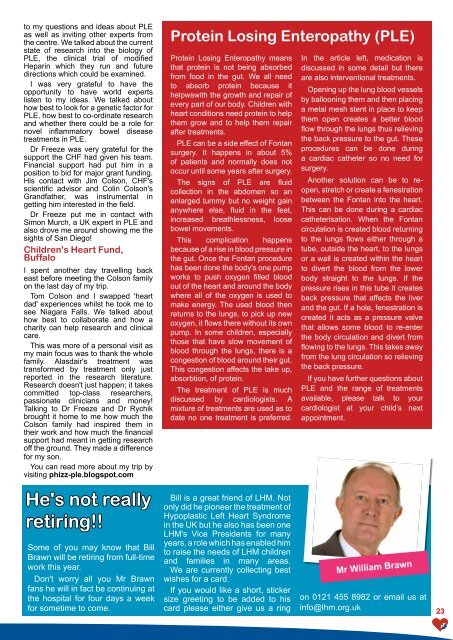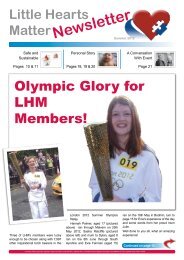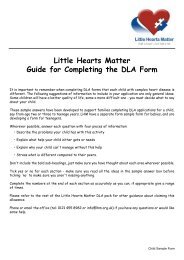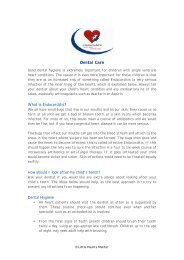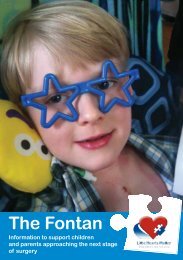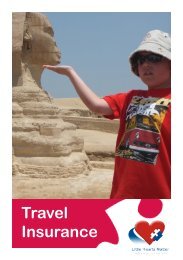here - Little Hearts Matter
here - Little Hearts Matter
here - Little Hearts Matter
Create successful ePaper yourself
Turn your PDF publications into a flip-book with our unique Google optimized e-Paper software.
to my questions and ideas about PLEas well as inviting other experts fromthe centre. We talked about the currentstate of research into the biology ofPLE, the clinical trial of modifiedHeparin which they run and futuredirections which could be examined.I was very grateful to have theopportunity to have world expertslisten to my ideas. We talked abouthow best to look for a genetic factor forPLE, how best to co-ordinate researchand whether t<strong>here</strong> could be a role fornovel inflammatory bowel diseasetreatments in PLE.Dr Freeze was very grateful for thesupport the CHF had given his team.Financial support had put him in aposition to bid for major grant funding.His contact with Jim Colson, CHF'sscientific advisor and Colin Colson'sGrandfather, was instrumental ingetting him interested in the field.Dr Freeze put me in contact withSimon Murch, a UK expert in PLE andalso drove me around showing me thesights of San Diego!Children's Heart Fund,BuffaloI spent another day travelling backeast before meeting the Colson familyon the last day of my trip.Tom Colson and I swapped 'heartdad' experiences whilst he took me tosee Niagara Falls. We talked abouthow best to collaborate and how acharity can help research and clinicalcare.This was more of a personal visit asmy main focus was to thank the wholefamily. Alasdair's treatment wastransformed by treatment only justreported in the research literature.Research doesn't just happen; it takescommitted top-class researchers,passionate clinicians and money!Talking to Dr Freeze and Dr Rychikbrought it home to me how much theColson family had inspired them intheir work and how much the financialsupport had meant in getting researchoff the ground. They made a differencefor my son.You can read more about my trip byvisiting phizz-ple.blogspot.comProtein Losing Enteropathy (PLE)Protein Losing Enteropathy meansthat protein is not being absorbedfrom food in the gut. We all needto absorb protein because ithelpwswith the growth and repair ofevery part of our body. Children withheart conditions need protein to helpthem grow and to help them repairafter treatments.PLE can be a side effect of Fontansurgery. It happens in about 5%of patients and normally does notoccur until some years after surgery.The signs of PLE are fluidcollection in the abdomen so anenlarged tummy but no weight gainanyw<strong>here</strong> else, fluid in the feet,increased breathlessness, loosebowel movements.This complication happensbecause of a rise in blood pressure inthe gut. Once the Fontan procedurehas been done the body's one pumpworks to push oxygen filled bloodout of the heart and around the bodyw<strong>here</strong> all of the oxygen is used tomake energy. The used blood thenreturns to the lungs, to pick up newoxygen, it flows t<strong>here</strong> without its ownpump. In some children, especiallythose that have slow movement ofblood through the lungs, t<strong>here</strong> is acongestion of blood around their gut.This congestion affects the take up,absorbtion, of protein.The treatment of PLE is muchdiscussed by cardiologists. Amixture of treatments are used as todate no one treatment is preferred.In the article left, medication isdiscussed in some detail but t<strong>here</strong>are also interventional treatments.Opening up the lung blood vesselsby ballooning them and then placinga metal mesh stent in place to keepthem open creates a better bloodflow through the lungs thus relievingthe back pressure to the gut. Theseprocedures can be done duringa cardiac catheter so no need forsurgery.Another solution can be to reopen,stretch or create a fenestrationbetween the Fontan into the heart.This can be done during a cardiaccatheterisation. When the Fontancirculation is created blood returningto the lungs flows either through atube, outside the heart, to the lungsor a wall is created within the heartto divert the blood from the lowerbody straight to the lungs. If thepressure rises in this tube it createsback pressure that affects the liverand the gut. If a hole, fenestration iscreated it acts as a pressure valvethat allows some blood to re-enterthe body circulation and divert fromflowing to the lungs. This takes awayfrom the lung circulation so relievingthe back pressure.If you have further questions aboutPLE and the range of treatmentsavailable, please talk to yourcardiologist at your child’s nextappointment.He's not reallyretiring!!Some of you may know that BillBrawn will be retiring from full-timework this year.Don't worry all you Mr Brawnfans he will in fact be continuing atthe hospital for four days a weekfor sometime to come.Bill is a great friend of LHM. Notonly did he pioneer the treatment ofHypoplastic Left Heart Syndromein the UK but he also has been oneLHM's Vice Presidents for manyyears, a role which has enabled himto raise the needs of LHM childrenand families in many areas.We are currently collecting bestwishes for a card.If you would like a short, stickersize greeting to be added to hiscard please either give us a ringMr William Brawnon 0121 455 8982 or email us atinfo@lhm.org.uk23


